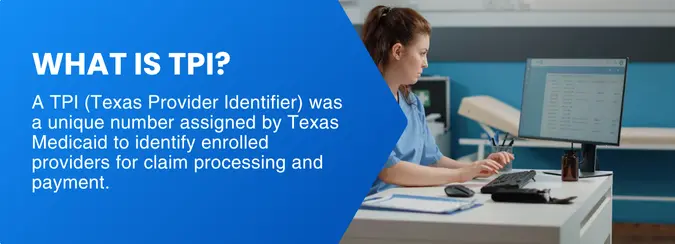Introduction
In medical billing, correct provider identification is as critical as accurate coding. Even the most meticulously coded claim can be denied if payer systems cannot match the provider details to their authorized records. Historically, Texas Medicaid used a TPI (Texas Provider Identifier) number to ensure clean claims routing and payment accuracy.
While the National Provider Identifier (NPI) is now the federally mandated standard, understanding what the TPI was, how it interacted with NPIs, and why it was retired is important for billing professionals, coders, and administrators particularly when auditing historical claims or reconciling legacy system data.
This guide explains the definition, purpose, and historical significance of the TPI number in Texas medical billing, the compliance changes that removed it, and the operational impacts of the transition to NPI-only workflows.
What Is a TPI Number?

The Texas Provider Identifier (TPI) was a state-specific billing number assigned by the Texas Medicaid & Healthcare Partnership (TMHP) to uniquely identify providers participating in Texas Medicaid programs.
Key Characteristics:
- Scope: State-level identifier (valid only in Texas Medicaid and related state programs).
- Format: A 9-digit numeric code tied to the provider’s enrollment record, issued by TMHP and unique to each enrolled provider or entity (TMHP; Clinical Gate; Prospect Healthcare Solutions).
- Purpose: Directed claims to the correct provider account, ensuring payments were routed to the right entity.

Unlike the NPI which is federally recognized and used across all payers, the TPI was a Texas-only operational requirement. It was entered in specific fields on paper and electronic claim forms alongside the NPI to validate provider credentials.
Historical Use and Phase-Out
The TPI was a mandatory data element in Texas Medicaid billing workflows for decades.
Before 2007, Texas Medicaid required only the TPI; after the NPI mandate took effect (May 23, 2007), both identifiers were used in parallel for a transition period.
Phase-Out Timeline:
- 2007–2021: TPI continued to appear alongside NPI on claims for Texas Medicaid.
- September 1, 2021: TMHP officially removed the TPI from claim forms, EDI transactions, and billing instructions.
- Systems Transition Clarification: TMHP accepted TPI-inclusive claim forms during a short transition period roughly until November 30, 2021 before enforcing full rejection of any submissions containing a TPI.
- Post-2021: NPI became the sole provider identifier accepted for Texas Medicaid claim submission.
The removal aligned Texas Medicaid with national standardization goals and reduced redundancy in claims processing.
TPI vs. NPI — Understanding the Difference
| Factor | TPI (Texas Provider Identifier) | NPI (National Provider Identifier) |
|---|---|---|
| Scope | Texas Medicaid only | All U.S. payers (federal & commercial) |
| Issuer | TMHP (Texas Medicaid) | CMS (Centers for Medicare & Medicaid Services) |
| Format | Numeric code (state-specific) | 10-digit numeric code |
| Purpose | State-level claim routing & payment | National standard provider identification |
| Status | Retired as of Sept. 1, 2021 | Active & mandatory |
Why TPI Numbers Were Important
Before retirement, TPIs played several critical roles:
- Payment Routing: Ensured funds were directed to the correct provider or group account in TMHP’s payment system.
- Error Prevention: Reduced mismatches between claim data and provider enrollment records.
- Fraud Control: Helped detect billing from unauthorized or unregistered providers.
- Group Practice Identification: Linked individual providers to their group or facility contracts in Medicaid’s database.
Inaccurate or missing TPIs often led to claim rejections, delayed payments, or compliance flags during payer audits.
Transition Impact & Compliance Considerations
When the Texas Provider Identifier (TPI) was retired in 2021, providers had to take several key steps to ensure a smooth transition to the NPI-only standard. Billing systems needed to be updated to remove TPI fields from electronic claim templates, preventing submission errors. Staff training was essential so that front-desk, billing, and coding teams fully understood the change and its impact on claim processing. Contracts with third-party billing services also required revision, as many contained references to the TPI. Finally, verifying NPI accuracy became critical, since any mismatch with the CMS NPI registry could result in claim rejections and payment delays.
Compliance Note: Claims submitted with a TPI after September 1, 2021, were rejected by TMHP, making timely transition critical to revenue flow.
Broader Context: Other State-Level Identifiers
In a broader context, while the Texas Provider Identifier (TPI) was unique to Texas, other states have historically used similar identifiers for Medicaid and specialty billing purposes. Examples include the Medicaid Provider Number, issued by state Medicaid agencies to route claims, and state-specific license numbers required for certain services such as behavioral health. For billers and coders, the best practice is to maintain a detailed compliance checklist for every state in which their providers operate. This ensures readiness for state-specific requirements, which can change with minimal notice, helping to prevent claim rejections and maintain regulatory compliance.
Best Practice for Billers & Coders: Maintain a compliance checklist for each state your providers serve, as state-specific requirements can change with minimal notice.
Conclusion
The TPI number served as a crucial operational link in Texas Medicaid’s claims system for decades. Its role in payment routing, fraud prevention, and claim accuracy was significant, especially for multi-provider groups and high-volume practices.
However, with its removal in September 2021, Texas Medicaid fully aligned with the federal NPI standard, streamlining claim submission and reducing administrative redundancy.
For today’s medical billers and coders, the main takeaway is this:
- Always verify current payer requirements.
- Keep historical context in mind when auditing or rebilling older claims.
- Ensure your systems are configured for compliance with current identifiers to avoid rejections, delays, and audit risks.
Accurate billing starts with accurate provider identification. Whether you’re coding in a small clinic or managing enterprise-level RCM, understanding the evolution from TPI to NPI ensures you remain compliant, efficient, and audit-ready



